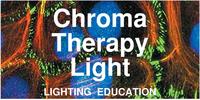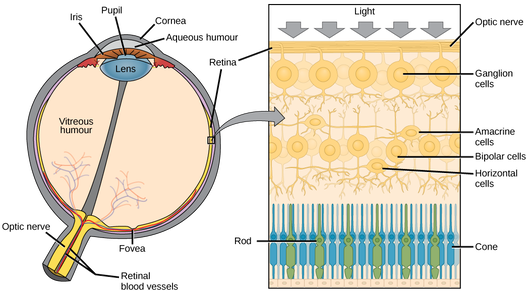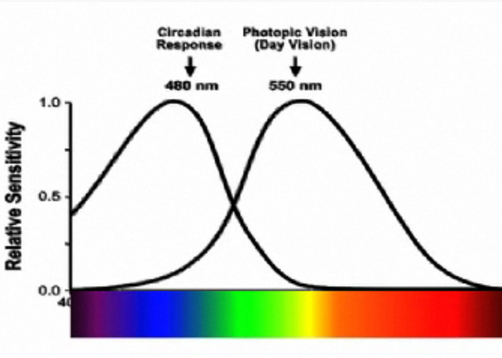Circadian System Ganglion Cells - Learning Objectives
The sun plays an important role in our wake and sleep cycles, known as your Circadian Rhythm. Ganglion cells in your eyes detect light and send signals to your pineal gland where hormones are produced that regulate sleep and wake cycles.
When were Ganglion Cells discovered?In 2005, Panda, Melyan, Qiu, and colleagues demonstrated that the melanopsin photopigment was the phototransduction pigment in ganglion cells. Other research reports appeared as early as 1998.
Photo Receptors in your EyesPhoto receptors in your eyes include Rods, Cones, and Ganglion Cells,a third kind of photoreceptor that contains a light-sensitive substance called melanopsin not found in rods and cones.
Intrinsically Photosensitive Subset of Retinal Ganglion CellsIt has been accepted for a hundred years or more that rods and cones are the only photoreceptive cells in the retina. The light signals generated in rods and cones, after processing by downstream retinal neurons (bipolar, horizontal, amacrine and ganglion cells), are transmitted to the brain via the axons of the ganglion cells for further analysis. In the past few years, however, convincing evidence has rapidly emerged indicating that a small subset of retinal ganglion cells in mammals is also intrinsically photosensitive. Melanopsin is the signaling photopigment in these cells. The main function of the inner-retina photoreceptors is to generate and transmit non-image-forming visual information, although some role in conventional vision (image detection) is also possible. [1] 2005 Department of Neuroscience, Johns Hopkins University School of Medicine, Baltimore, Maryland, USA
You Tube video explains Ganglion CellsIn addition to Rods for night vision, and Cones for color vision, Ganglion cells for controlling Melanopsin regulating hormones Melatonin and Serotonin
Photobiologists and Circadian System Researchers explain how light affects human biology and trends in Circadian Adjusted lighting. Watch this excellent 11 minute video. https://www.youtube.com/watch?v=ZrKkzm2HQAo 2018 Report on Circadian PhotoentrainmentIntrinsically photosensitive retinal ganglion cells (ipRGCs) mediate not only image-forming vision like other ganglion cells, but also non-image-forming physiological responses to light such as pupil constriction and circadian photoentrainment. [2] 2018 Department of Ophthalmology & Visual Sciences, University of Michigan, Ann Arbor, MI, United States and Department of Molecular, Cellular & Developmental Biology, University of Michigan, Ann Arbor, MI, United States
Melatonin & SerotoninThe importance of the pineal gland in circadian physiology is evident in the more than 1,000 research articles published during the past decade. [3]
Hormones - Melatonin and Serotonin, are created in our bodies to signal us to sleep and wake. The pineal gland produces melatonin, a serotonin-derived hormone which modulates sleep patterns in both circadian and seasonal cycles. Melatonin is produced at night to direct our bodies to sleep. Exposure to blue tinted light can delay sleep for as much as two hours. Serotonin impacts every part of your body, from your emotions to your motor skills. Serotonin is considered a natural mood stabilizer. It’s the chemical that helps with sleeping, eating, and digesting. Serotonin also plays an important role in sleep because the body uses it to synthesize melatonin. |
Melanopsin-expressing, Intrinsically Photosensitive Retinal Ganglion Cells (ipRGCs)These intrinsically photosensitive retinal ganglion cells (ipRGCs) are a rare subpopulation of ganglion cells (<5%) whose primary role is to signal light for largely subconscious, non-image-forming visual reflexes, such as pupillary constriction, neuroendocrine regulation, and synchronizing daily (“circadian”) physiological rhythms to the light/dark cycle (“circadian photoentrainment”). Recent research has revealed additional roles for ipRGCs in conscious visual perception, including brightness discrimination and contrast detection. Many visual behaviors under ipRGC control are remarkably tonic, and require prolonged integration of ambient light levels. The unique properties of ipRGCs make them well suited for regulating such behaviors. [4] Graham DM, Wong KY. Melanopsin-expressing, Intrinsically Photosensitive Retinal Ganglion Cells (ipRGCs). In: Kolb H, Fernandez E, Nelson R, eds. Webvision: The Organization of the Retina and Visual System. Salt Lake City (UT): University of Utah Health Sciences Center; 1995.
Circadian BrainBrain Signals
The controller of our Circadian System producing Melatonin is the Pineal Gland, this part of the Endocrine System, sometimes referred to as the 'third eye' is located deep inside our brain, directly above the optic chiasm. . It receives signals though our eyes, collecting information about light intensity and color via the optic nerves. "Suprachiasmatic nuclei (SCN), located in the hypothalamus above the optic chiasm."
Cyto-architecture is a biology term used to describe the study of the arrangement of cells and how this affects the performance of each organ. Often referred to as study of the brain structure, 'cyto' means 'cells' and 'architecture' originates from Greek arkhitekton 'master builder.' Studying the architecture of the brain, is analogous to the study of buildings, their manner of construction and the arrangement of their parts. As recently as 2002 scientists discovered photoreceptors called ganglion cells (RGC) in our eye's retina that respond to light and send signals to our circadian system. Scientists continue to search for understanding of the brain circuits, receptors, and their functions. [5] Footnotes
Photo Credits
|
- Home
-
- CHROMA Topics
- Color Spectrum - Light is Energy
- Color in Light
- Color in Nature
- Color in Paint
- Why does paint fade?
- Color Names & Meanings
- Color Phenomena
- Color Perception is Individual
- Color In Fashion
- Color for your home
- Color in Space
- Color Blindness
- Color Blind Interview
- Synesthesia
- Synesthete Deborah Borrowdale-Cox
- Synesthete Stephen Orr, BH&G Editor
-
- Circadian & THERAPY Topics
- Circadian Explained
- Circadian Ganglion Cells
- Circadian Melatonin
- Circadian Animals
- Circadian Research
- Autism & Lighting for the Spectrum
- Blue Light Dimming Apps
- Red Night Lights
- Vitamin D & Light
- SAD - Seasonal Affective Disorder
- Alzheimers and Light Therapy
- Photosensitivity - Light Sensitive Drugs
- Red Light Therapy
- Sleep & Lighting
- Dreams and Second Sleep
- NASA - Lighting in Space & Undersea
- Jet Lag
- Sunglasses
- Chakras
- Crystals, Minerals, & Gemstones
-
- LIGHTing Design Topics
- UV Germicidal Disinfection Light
- LED Lighting Facts Card
- CRI - Color Rendering Index
- LED TM-30
- LED Kelvin Color
- LED LPW
- LED Flicker
- LED Glare
- OLED - Organic LED
- Human Centric Lighting
- Lighting with Daylighting
- Lighting for Healthy Buildings & Zero Net Energy
- Lighting for Healthcare
- Lighting for Horticulture
- Lighting for Hospitality & LED Retrofits
- Lighting for Museums
- Lighting for Seniors & Low Vision
- Lighting Design Tips & Codes
- Parking Lot Lighting
- Solar Lighting for Humanity & World Health
- Davis Insectary Garden
- Santa Barbara Mesa Insectary Garden
- Home
-
- CHROMA Topics
- Color Spectrum - Light is Energy
- Color in Light
- Color in Nature
- Color in Paint
- Why does paint fade?
- Color Names & Meanings
- Color Phenomena
- Color Perception is Individual
- Color In Fashion
- Color for your home
- Color in Space
- Color Blindness
- Color Blind Interview
- Synesthesia
- Synesthete Deborah Borrowdale-Cox
- Synesthete Stephen Orr, BH&G Editor
-
- Circadian & THERAPY Topics
- Circadian Explained
- Circadian Ganglion Cells
- Circadian Melatonin
- Circadian Animals
- Circadian Research
- Autism & Lighting for the Spectrum
- Blue Light Dimming Apps
- Red Night Lights
- Vitamin D & Light
- SAD - Seasonal Affective Disorder
- Alzheimers and Light Therapy
- Photosensitivity - Light Sensitive Drugs
- Red Light Therapy
- Sleep & Lighting
- Dreams and Second Sleep
- NASA - Lighting in Space & Undersea
- Jet Lag
- Sunglasses
- Chakras
- Crystals, Minerals, & Gemstones
-
- LIGHTing Design Topics
- UV Germicidal Disinfection Light
- LED Lighting Facts Card
- CRI - Color Rendering Index
- LED TM-30
- LED Kelvin Color
- LED LPW
- LED Flicker
- LED Glare
- OLED - Organic LED
- Human Centric Lighting
- Lighting with Daylighting
- Lighting for Healthy Buildings & Zero Net Energy
- Lighting for Healthcare
- Lighting for Horticulture
- Lighting for Hospitality & LED Retrofits
- Lighting for Museums
- Lighting for Seniors & Low Vision
- Lighting Design Tips & Codes
- Parking Lot Lighting
- Solar Lighting for Humanity & World Health
- Davis Insectary Garden
- Santa Barbara Mesa Insectary Garden







